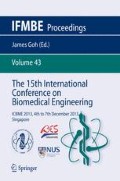Abstract
Atypical femoral fractures (AFF) are predominantly transverse stress fractures from the lateral aspect of the subtrochanteric and diaphyseal region for which long-term bisphosphonate treatment have been suggested an important determinants. However, the physiological loading environment triggering AFFs in typical femoral regions remain largely unexplored. The aim of this study was to test the hypothesis that typical AFFs onset location is associated with high daily cyclic tensile strains. The study was based on body- and organlevel models from a single donor (female, 81- years- old) and motion data recorded from a body-matched volunteer (female, 25 years-old). Models were the donor’s lower-limb musculoskeletal model validated against published measurements of the hip reaction force and the finite-element model of the donor’s right femur validated against measurements of cortical strains. Motion data including skin marker trajectories and ground reaction forces were recorded from the volunteer during walking, which is the most frequent daily activity. The muscle and hip forces were calculated using the musculoskeletal model and applied to the finite-element model to calculate the cortical tensile and compressive strains in two extreme sections of the femoral diaphysis. The anterior, medial, posterior and lateral femoral aspects were assumed at 0°, 90°, 180°, and 270° respectively. In the sub-trochanteric section the peak tensile strain during stance was 1300-2287 με constantly located laterally (270°-300°) and the peak compressive strain was 1433-2730 με constantly located medially (90°). In the distal diaphysis the peak tensile strain varied from 1714 με to 4171 με located antero-laterally at 300°-330° and the peak compressive strain varied from 1813 με to 4674 με located posteromedially (90°-150°). We conclude that high cyclic tensile strains determine the typical AFFs onset location whereas more research is necessary to understand how different activities and the individual anatomy affect the femur’s physiological tensile loads.
Access this chapter
Tax calculation will be finalised at checkout
Purchases are for personal use only
Preview
Unable to display preview. Download preview PDF.
Author information
Authors and Affiliations
Editor information
Editors and Affiliations
Rights and permissions
Copyright information
© 2014 Springer International Publishing Switzerland
About this paper
Cite this paper
Martelli, S., Pivonka, P., Ebeling, P.R. (2014). Investigation of Determinants of Atypical Femoral Fractures Using Multiscale Computational Modeling. In: Goh, J. (eds) The 15th International Conference on Biomedical Engineering. IFMBE Proceedings, vol 43. Springer, Cham. https://doi.org/10.1007/978-3-319-02913-9_82
Download citation
DOI: https://doi.org/10.1007/978-3-319-02913-9_82
Publisher Name: Springer, Cham
Print ISBN: 978-3-319-02912-2
Online ISBN: 978-3-319-02913-9
eBook Packages: EngineeringEngineering (R0)

